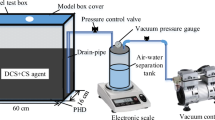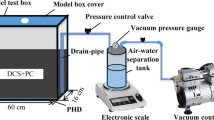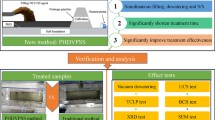Abstract
Land reclamation projects are increasingly incorporating dredged sediment from waterways. The high water content of dredged sediment is a major issue, making the dewatering process difficult and time-consuming. The chemical-physical combined method (CP) is therefore used in this study, which simultaneously uses vacuum dewatering by utilising vacuum pressure (VP) in conjunction with prefabricated horizontal drain (PHD) and Portland cement (PC)-based solidification/stabilisation (SS), thereby significantly reducing the duration of treatment of DS with high water content. The effectiveness and feasibility of the chemical-physical combined method with Portland cement (PC) as a binder are evaluated and compared with the traditional PC-based solidification/stabilisation (SS) method. A number of experimental tests were performed to accomplish the objectives of the study, such as unconfined compressive strength (USS), X-ray diffraction (XRD), and scanning electron microscopy (SEM). The experimental results indicated that the CP method showed better performance compared to the traditional SS method in treating high water content DS at low cement content. The water content of DS treated with the chemical-physical combined method was reduced by half in just about 3 days, and the final rate of settlement was 2.9 times higher than with SS-treated DS. The USC results showed that the strength of CP cases was 4.8 times higher than SS-treated DS after 56 days of curing age. The microstructural tests revealed the development of CSH and CASH as major hydration products of both CP and SS cases. Moreover, CP cases exhibited a densely stabilised matrix compared to SS cases.









Similar content being viewed by others
Data availability
Not applicable.
References
ASTM D (2008) Standard test method for unconfined compressive strength index of chemical-grouted soils. ASTM International
Bahari A, Sadeghi‐Nik A, Shaikh FUA, Sadeghi‐Nik A, Cerro‐Prada E, Mirshafiei E, Roodbari M (2021): Experimental studies on rheological, mechanical, and microstructure properties of self‐compacting concrete containing perovskite nanomaterial. Structural Concrete
Batchelor B (2006) Overview of waste stabilization with cement. Waste Manage 26:689–698
Cai Y, Qiao H, Wang J, Geng X, Wang P, Cai Y (2017) Experimental tests on effect of deformed prefabricated vertical drains in dredged soil on consolidation via vacuum preloading. Eng Geol 222:10–19
Calgaro L, Contessi S, Bonetto A, Badetti E, Ferrari G, Artioli G, Marcomini A (2021): Calcium aluminate cement as an alternative to ordinary Portland cement for the remediation of heavy metals contaminated soil: mechanisms and performance. Journal of Soils and Sediments in press
Chew SH, Kamruzzaman AHM, Lee FH (2004) Physicochemical and engineering behavior of cement treated clays. J Geotech Geoenviron Eng 130:696–706
China NscgotpsRo (2019): GB/T 50123–2019 standard for soil test methods. China Planning Press Beijing
D A (2001): Standard test method for pH of soils. Annual book of ASTM Standards 4, 1-3
Du Y-J, Bo Y-L, Jin F, Liu C-Y (2016) Durability of reactive magnesia-activated slag-stabilized low plasticity clay subjected to drying–wetting cycle. Eur J Environ Civ Eng 20:215–230
Du YJ, Jiang NJ, Liu SY, Jin F, Singh DN, Puppala AJ (2014) Engineering properties and microstructural characteristics of cement-stabilized zinc-contaminated kaolin. Can Geotech J 51:289–302
Fatah TA, Zhang R-J, Huang X-S, Miao Y, Mastoi AK (2021): Strength Characteristics and heavy metal leaching behavior of contaminated mining sludge at extra high water content solidified/stabilized with lime activated GGBS or OPC
Goodarzi AR, Movahedrad M (2017) Stabilization/solidification of zinc-contaminated kaolin clay using ground granulated blast-furnace slag and different types of activators. Appl Geochem 81:155–165
Griffin H, O’Kelly BC (2014) Ground improvement by vacuum consolidation–a review. Proceedings of the Institution of Civil Engineers-Ground Improvement 167:274–290
Kamruzzaman AHM, Chew SH, Lee FH (2006) Microstructure of cement-treated Singapore marine clay. Proc Inst Civ Eng-Ground Improv 10:113–123
Khalid U, Liao CC, Gl Ye, Yadav SK (2018) Sustainable improvement of soft marine clay using low cement content: a multi-scale experimental investigation. Constr Build Mater 191:469–480
Khoteja D, Zhou Y, Pu H, Pan Y (2021): Rapid treatment of high-water-content dredged slurry using composite flocculant and PHD-facilitated vacuum. Mar Georesour Geotechnol 1–30
Kogbara RB (2014) A review of the mechanical and leaching performance of stabilized/solidified contaminated soils. Environ Rev 22:66–86
Lang L, Chen B, Li N (2020a): Utilization of lime/carbide slag-activated ground granulated blast-furnace slag for dredged sludge stabilization. Mar Georesour Geotechnol 1–11
Lang L, Liu N, Chen B (2020) Strength development of solidified dredged sludge containing humic acid with cement, lime and nano-SiO2. Constr Build Mater 230:116971
Lorenzo GA, Bergado DT (2006) Fundamental characteristics of cement-admixed clay in deep mixing. J Mater Civ Eng 18:161–174
Malviya R, Chaudhary R (2004) Study of the treatment effectiveness of a solidification/stabilization process for waste bearing heavy metals. J Mater Cycles Waste Manage 6:147–152
Malviya R, Chaudhary R (2006) Factors affecting hazardous waste solidification/stabilization: a review. J Hazard Mater 137:267–276
Mastoi AK, Pu H, Chen X, Nyanzi AS, Jhatial AA (2021): Physico-mechanical and microstructural behaviour of high-water content zinc-contaminated dredged sediment treated with integrated approach PHDVPSS. Environ Sci Pollut Res 1–11
Mulligan CN, Yong RN, Gibbs BF (2001) An evaluation of technologies for the heavy metal remediation of dredged sediments. J Hazard Mater 85:145–163
Paria S, Yuet PK (2006) Solidification-stabilization of organic and inorganic contaminants using portland cement: A literature review. Environ Rev 14:217–255
Pu H, Mastoi AK, Chen X, Song D, Qiu J, Yang P (2020) An integrated method for the rapid dewatering and solidification/stabilization of dredged contaminated sediment with a high water content. Front Environ Sci Eng 15:1–12
Wang HS, Tang CS, Gu K, Shi B, Inyang HI (2020a) Mechanical behavior of fiber-reinforced, chemically stabilized dredged sludge. Bull Eng Geol Env 79:629–643
Wang P, Han Y, Zhou Y, Wang J, Cai Y, Xu F, Pu H (2020b) Apparent clogging effect in vacuum-induced consolidation of dredged soil with prefabricated vertical drains. Geotext Geomembr 48:524–531
Wang S, Lang L, Wei M, He X, Wang R, Yu C, Feng S, Niu Z, Ma H (2021): Strength and microstructural characteristics of cement-solidified salt-rich dredged silt modified by nanoparticles. Mar Georesour Geotechnol 1–12
Wu DQ, Xu WY, Zhu DP (2013): The chemical-physical combined method for improving clay slurry in land reclamation 308–315
Zhang R-j, Dong C-q, Lu Z, Pu H-f (2019) Strength characteristics of hydraulically dredged mud slurry treated by flocculation-solidification combined method. Constr Build Mater 228:116742–116742
Acknowledgements
Both the Institute of Geotechnical and Underground Engineering at the Huazhong University of Science and Technology in Wuhan and the Department of Civil Engineering at the Quaid-e-Awam University of Engineering Science and Technology in Nawabshah in Pakistan have provided assistance to the authors, and they wish to express their appreciation for this assistance.
Author information
Authors and Affiliations
Contributions
Aamir Khan Mastoi: conceptualisation, investigation, methodology, formal analysis, data analysis, writing—original draft, writing—review & editing.
Riaz Ahmed Bhanbhro: formal analysis, data analysis, writing—original draft.
Traore Abdoul Fatah: data analysis, writing—original draft, writing—review & editing.
Mahboob oad: investigation, methodology.
Shahnawaz Zardari: writing—review & editing.
Ashfaque Ahmed Jhatial: review & editing, proofreading.
Corresponding author
Ethics declarations
Ethics approval and consent to participate
Not applicable.
Consent for publication
All Authors consent for Publication
Conflict of interest
The authors declare no competing interests.
Additional information
Responsible Editor: Philippe Garrigues
Publisher's Note
Springer Nature remains neutral with regard to jurisdictional claims in published maps and institutional affiliations.
Rights and permissions
About this article
Cite this article
Mastoi, A.K., Bhanbhro, R., Traore, A.F. et al. Preliminary investigation of high-water content dredged sediment treated with chemical-physical combined method at low cement content. Environ Sci Pollut Res 29, 32763–32772 (2022). https://doi.org/10.1007/s11356-021-18167-x
Received:
Accepted:
Published:
Issue Date:
DOI: https://doi.org/10.1007/s11356-021-18167-x




